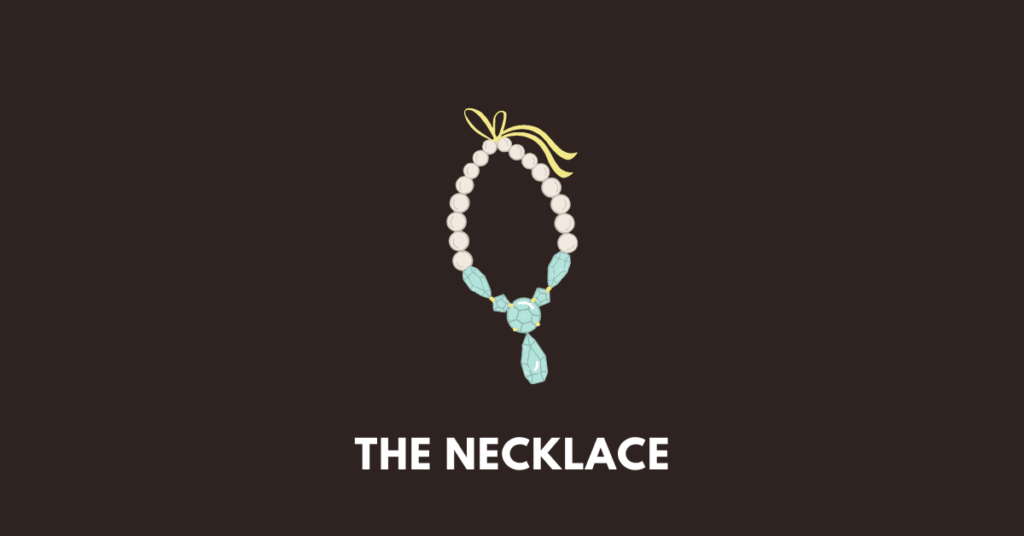The (Diamond) Necklace: TBSE, BSEM Class 10 English answers
Get here the summary, questions, answers, textbook solutions, extras, and pdf of the story “The Necklace” by Guy de Maupassant. However, the given notes/solutions should only be used for references and should be modified/changed according to needs.

| Select your version |
| Summary and extras for all |
| TBSE Class 10 book specific notes |
| BSEM Class 10 book specific notes |
Summary
The story “The Necklace” tells the story of a woman from a lower middle-class background who was never happy with who she was or what she had, and consequently, she met with a tragic end. She never got over the fact that she did not have a lavish lifestyle and eventually gave in to the urge to have one. In order for her to go to the ball, she borrowed a diamond necklace from a friend who was wealthy. She was forced to endure a challenging struggle in order to make up for the loss of this piece of jewellery, which she, unfortunately, lost.
It’s hard to resist the allure of Madame Matilda Loisel’s affable smile and lovely demeanour. She thinks she was made for the finer things in life. She laments her fate on a regular basis because she is poor and cannot afford her extravagant aspirations.
Matilda, who is married to Loisel, a clerk at the Ministry of Public Instruction, makes her own life more miserable by constantly contrasting it with her ideal, more affluent existence. Her husband is concerned about her and tries to lift her spirits by praising the simple pleasures of their daily lives. Later, he gives her a party invitation he received from the Minister of Public Instruction. And now that she has received this invitation, Matilda is feeling even worse about her situation. She becomes enraged because she has nothing to wear to the formal event. Not wanting to let this opportunity pass, her husband gladly forks over the 400 francs he had set aside for a hunting gun so that Matilda could purchase an appropriate dress for the occasion.
Loisel observes Matilda’s glum demeanour a few days prior to the ball party. When he inquires as to why, she says that she does not own any suitable jewellery to complement the dress. He suggests she accessorise with some fresh flowers, but Matilda is not keen on the idea. Their friend, Madame Forestier, is very wealthy, so her husband suggests that she borrow the jewellery from her. Matilda thinks this is a good plan, so she visits her friend the following day to discuss the issue. The generous Madame Forestier lets Matilda take whatever she likes from the jewellery box. Matilda takes a magnificent diamond necklace from the collection after examining and admiring it.
Matilda arrives at the ball in her new dress and diamond necklace, looking beautiful, gracious, happy, and full of life. Her beauty and charisma make her the centre of attention at the party. While Matilda’s husband waits patiently in one of the little salons, she takes in all the attention. The couple gets up at four in the morning and heads back home. On the way back, they have trouble securing a carriage and are completely spent when they finally get there. At bedtime, Matilda discovers to her horror that she has lost her necklace.
Loisel, disappointed, searches high and low but can’t seem to find her missing jewellery. At last, he suggests that Matilda write her friend an explanation letter explaining that the necklace’s clasp has broken and that she plans to have it fixed. Loisel hoped to delay the inevitable so that he could make up for his loss. He eventually tracks down a copy of the stolen artwork at the Palais Royal, where it is being sold for thirty-six thousand francs despite being appraised at forty thousand. He takes out a loan and puts it together with the eighteen thousand francs he received from his father’s estate. After that, he goes and retrieves the new diamond chaplet. Matilda gives the jewellery back to her friend and is relieved that the change won’t be discovered.
But now the Loisel couple must begin a protracted and trying ordeal. They have taken on a very frugal way of life and reduced their spending significantly in order to pay off their debt. They get rid of the maid and move into a new place, which has an attic that they can rent out for extra space. Matilda’s life is filled with destitution, hunger, and misery for the next decade. Her appearance is ugliness personified due to her wrinkled face, untidy hair, and sloppy attire.
Eventually, she runs into her friend, Mme Forestier. Matilda’s appearance shows the years of effort she has put in. Mme. Forestier has trouble recognising her and wonders what has caused the sudden transformation. Matilda tells her the truth about the missing necklace. An unexpected turn of events follows. After Matilda expresses her gratitude for the diamond necklace she lent her, Madame Forestier breaks the news that it was actually a fake worth less than 500 francs.

Additional/extra questions and answers/solutions
1. What set Matilda apart from other women? What kind of aspirations did she have?
Answer: In contrast to other women of her status, Matilda was stunningly beautiful, sophisticated, and refined. She fantasised about lavish parties with all the fine china, silverware, jewellery, and clothing that money could buy.
2. Why did Matilda marry a petty clerk, despite the fact that she believed she was born for luxuries?
Answer: Despite coming from a long line of clerks, Matilda felt she was destined for a life of finery and married a petty clerk anyway. She came from a poor family and therefore had no chance of marrying into the upper class or gaining social status by association with her husband.
14. What was Matilda afraid of when she returned the necklace to Mme Forestier?
Answer: Matilda was nervous that Mme Forestier would open the jewellery box and discover the change when she returned the necklace to her. Or, she could label her as a thief and make a snide remark.
15. How has Matilda spent the ten years since she returned from the ball?
Answer: To pay off their debt, the Loisels needed ten long years. Matilda displayed heroic resilience during that time. She dismissed the maid, took on all the housework herself, and rented out space in the attic. She helped her husband pay off the debt by dressing modestly and saving money by haggling with the grocer and butcher.
16. How did M. Loisel repay the debt?
Answer: To pay off his debt, M. Loisel put in extra hours at work. He also did nighttime copying for five sous per page and helped organise the merchants’ books. It took him ten years, but he eventually paid off his debt through this approach.
17. What changes occurred in Matilda’s emotional state after ten years of hard work?
Answer: Due to her ten years of hard labour, Matilda is now an emotionally resilient woman. She no longer felt sorry for herself or bitter about her circumstances. The crisis had made her stronger, and she was proud of herself for making it through. Despite her past insecurities, she now presents herself with confidence.
18. Why didn’t Mme Forestier recognise Matilda near the end of the story?
Answer: After ten years of relentless toil, Matilda had lost all of her enchantment and sophistication. Somehow, she went from being a refined beauty to a stout, crony-like housewife. Such was the extent of Matilda’s transformation that Jeanne Forestier no longer recognised her as her friend.
19. What would have happened if Matilda had told her friend she had misplaced the necklace?
Answer: Matilda could have been put in an extremely difficult and humiliating situation if she had confessed to Mrs Forestier. But the Loisels could have avoided that tedium for ten years by simply paying the necklace’s actual value.
Get notes of other classes and subjects